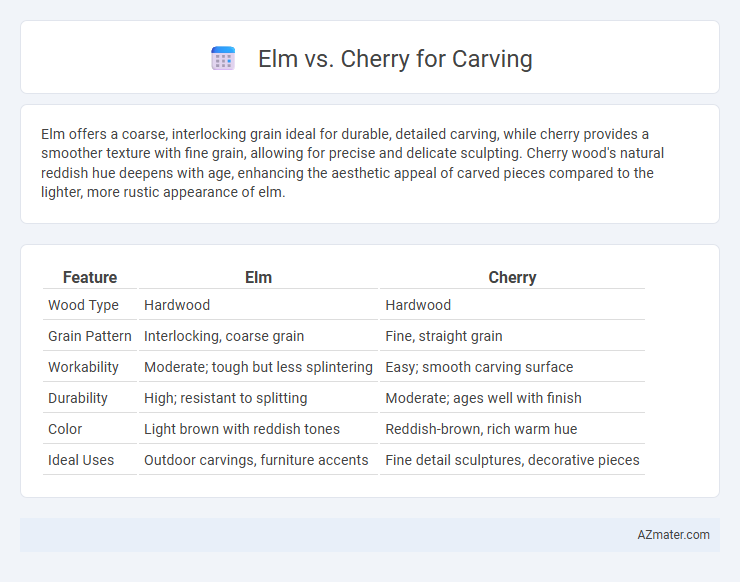Elm offers a coarse, interlocking grain ideal for durable, detailed carving, while cherry provides a smoother texture with fine grain, allowing for precise and delicate sculpting. Cherry wood's natural reddish hue deepens with age, enhancing the aesthetic appeal of carved pieces compared to the lighter, more rustic appearance of elm.
Table of Comparison
| Feature | Elm | Cherry |
|---|---|---|
| Wood Type | Hardwood | Hardwood |
| Grain Pattern | Interlocking, coarse grain | Fine, straight grain |
| Workability | Moderate; tough but less splintering | Easy; smooth carving surface |
| Durability | High; resistant to splitting | Moderate; ages well with finish |
| Color | Light brown with reddish tones | Reddish-brown, rich warm hue |
| Ideal Uses | Outdoor carvings, furniture accents | Fine detail sculptures, decorative pieces |
Introduction to Elm and Cherry for Carving
Elm wood, prized for its interlocking grain, offers excellent resistance to splitting, making it a favored choice for intricate carving projects requiring durability and fine detail. Cherry wood, known for its smooth texture and rich reddish-brown hue, carves cleanly and polishes to a lustrous finish, ideal for creating elegant, refined carvings. Both woods provide distinct benefits in carving, with elm excelling in strength and cherry standing out for its aesthetic appeal and workability.
Wood Grain and Texture Comparison
Elm wood features interlocking grain that provides excellent strength and resistance to splitting, making it suitable for detailed carving with durability. Cherry wood offers a fine, straight grain with a smooth texture, allowing for precise, clean cuts and a polished finish in carving projects. Elm's coarse texture contrasts with Cherry's smooth surface, influencing the final appearance and tactile quality of carved pieces.
Workability: Ease of Carving
Elm wood offers moderate workability with its interlocking grain that can sometimes cause challenges during carving but provides durability and fine detail when handled correctly. Cherry wood exhibits excellent ease of carving due to its fine, straight grain and uniform texture, allowing for smooth cuts and intricate detail work. Carvers often prefer cherry for projects requiring precision, while elm is chosen for its toughness and unique grain patterns despite slightly tougher workability.
Durability and Strength in Finished Pieces
Elm wood offers exceptional durability and resistance to splitting, making it highly suitable for carving projects requiring structural integrity and longevity. Cherry wood, prized for its fine grain and smooth finish, provides moderate strength but excels in achieving detailed, delicate carvings with a rich, warm color over time. Finished elm pieces tend to endure harsher conditions without damage, while cherry carvings offer aesthetic appeal with sufficient strength for decorative use.
Color and Aging Characteristics
Elm wood showcases a warm, golden-brown hue that deepens beautifully over time, developing a rich patina ideal for carving projects requiring natural elegance. Cherry wood offers a smooth, reddish-brown coloration that intensifies to a deep, rich amber with age, enhancing the carved details and providing a luxurious appearance. Both woods exhibit excellent aging characteristics, but Cherry's consistent color darkening contrasts with Elm's more varied grain pattern and color shifts, making choice dependent on desired final aesthetic.
Detail Retention and Finish Quality
Elm offers excellent detail retention due to its interlocking grain, which resists splitting and holds intricate carvings well. Cherry wood provides a smooth finish with a fine, uniform texture that enhances the overall appearance of carvings. Both woods finish beautifully, but Cherry tends to develop a richer patina over time, adding depth to detailed work.
Availability and Cost Factors
Elm wood, valued for its interlocking grain and durability, is moderately priced and widely available in North America and Europe, making it a favored choice for carving projects that require strength and intricate detail. Cherry wood, prized for its fine grain and smooth finish, tends to be more expensive and less abundant, especially high-quality veneers, due to slower growth rates and increased demand in fine woodworking and furniture making. Availability of elm may fluctuate regionally due to disease impact, but its cost-effectiveness and workability often outweigh these concerns, whereas cherry remains a premium option offering rich color and aging properties at a higher price point.
Suitability for Beginners vs. Experienced Carvers
Elm wood offers a moderate hardness and interlocking grain, making it suitable for beginners who need a forgiving material that resists splitting. Cherry wood, with its fine grain and smoother texture, is preferred by experienced carvers seeking detailed and precise work. Beginners often start with elm due to its workability, while cherry demands more skill to avoid chipping and achieve clean cuts.
Best Projects for Elm and Cherry Wood
Elm wood's interlocking grain provides excellent resistance to splitting, making it ideal for intricate carving projects such as bowls, spoons, and furniture accents that require durability and a coarse texture. Cherry wood offers a fine, smooth grain and rich reddish hue, perfect for detailed carvings like decorative panels, intricate figurines, and fine furniture embellishments where precision and a polished finish are essential. Both woods excel in different carving applications: elm suits robust, rustic pieces while cherry enhances refined, delicate creations.
Conclusion: Choosing Between Elm and Cherry for Carving
Elm offers a coarse, interlocking grain that provides excellent resistance to splitting, making it ideal for sturdy, textured carvings. Cherry features a fine, consistent grain that carves smoothly and polishes to a rich, warm finish favored for detailed and delicate work. Selecting between elm and cherry depends on the desired carving style: choose elm for robust, rustic projects and cherry for refined, elegant designs.

Infographic: Elm vs Cherry for Carving
 azmater.com
azmater.com